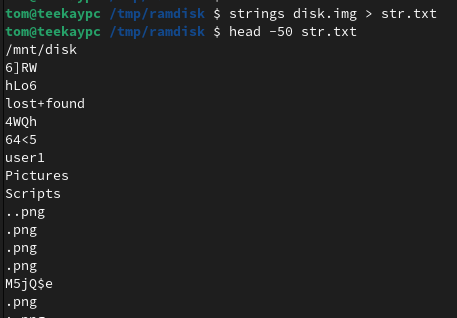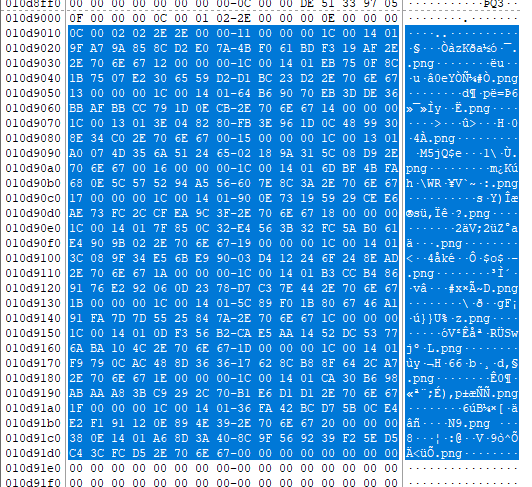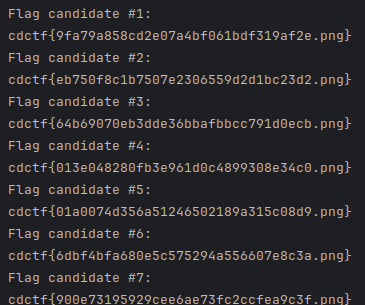CDCTF 2025 - Forensics - Foorensik challenges suite
Challenge: Forensics - Foorensik1 (1/2)
1. Task description
Flag in disk image. Forensic. Find it. You should know the drill. Flag Format cdctf{123_ex4mpl3_fl4g}
2. Initial analysis
We’re given the file disk.7z (1.2 MB) as the handout for both parts of this challenge suite. Once extracted, it produces a 1.1 GB disk image file disk.img. The disk image does not import well to Autopsy, so no files are instantly recognised. Executing strings on the disk image gives us a quick initial idea of what it contains:
Searching for common flag file extensions, other than .png, returns no results.
A quick verification with grep is also handy to make sure the disk image contains actual PNG data we could extract:
It seems there are 16 possible PNG files on the disk image.
3. PNG files extraction
A Python script could be used to extract all 16 PNG files from the disk image. The script:
- Reads the contents of the disk image file in binary mode
- Searches for occurrences of PNG headers (
89504e47in hex) - Searches for occurrences of PNG footers (
ae426082in hex) - Extracts what sits between each header-footer pair
- Saves it as a
.pngfile
1
2
3
4
5
6
7
8
9
10
11
12
13
14
15
16
17
18
19
20
21
22
23
24
25
26
27
28
29
30
31
#!/usr/bin/env python3
disk_file = "/tmp/ramdisk/disk.img"
png_header = bytes.fromhex("89504e47")
png_footer = bytes.fromhex("ae426082")
with open(disk_file, "rb") as f:
data = f.read()
files, start = [], 0
while True:
start = data.find(png_header, start) # return -1 if no header found
if start == -1:
break
end = data.find(png_footer, start) # return -1 if no footer after header found
if end == -1:
break
end += len(png_footer) # include footer
files.append(data[start:end])
start = end # move search forward
for i, content in enumerate(files, start=1):
filename = f"file{i}.png"
with open(filename, "wb") as out:
out.write(content)
print(f"Extracted {filename} ({len(content)} bytes)")
print(f"Done - {len(files)} extracted files in total.")
This results in all 16 PNG files extracted successfully. Most of them are cat memes. Meow. One contains the flag:
4. Flag
1
cdctf{67_kn33_surgerY}
Challenge: Forensics - Foorensik2 (2/2)
First blood by OP_EN; special acknowledgment from the event organisers.
1. Task description
That wasn’t too bad right? Now find the filename of the file containing the flag (in hex, except for extension) Flag format cdctf{000102030405060708090a0b0c0d0e0f.ext}
2. Initial analysis
PNG files do not contain their names anywhere between IHDR and IEND headers, so there is no way to determine the original name of the extracted flag file from its contents alone.
3. Data extraction
Importing the disk image into FTK Imager and searching for the .png extension shows a directory listing with all 16 occurrences of the .png extension:
Copy the hex data selected above, change it to lowercase (for example in CyberChef), and save it as a text file.
4. Filename extraction
As the flag format in the challenge description suggests, the filename consists of 32 lowercase hex characters, followed by the extension.
A Python script could be used for preparing a list of candidate flags for submission. The script:
- Reads the contents of the text file prepared above
- Searches for occurrences of the
.pngextension in hex - Gets the 32 hex characters that precede each
.pngextension - Prints a list of flag candidates for submission
1
2
3
4
5
6
7
8
9
10
11
12
13
14
15
16
17
18
19
20
21
22
23
24
25
26
27
#!/usr/bin/env python3
hex_data = "/tmp/ramdisk/hex_data.txt"
extension = "2e706e67" # .png in hex
with open(hex_data, "rt") as f:
data = f.read()
candidates, position = [], 0
while True:
index = data.find(extension, position) # return -1 if no .png found
if index == -1:
break
if index >= 32: # get 32 hex characters before .png if available
prefix = data[index-32:index]
filename = prefix + ".png"
candidates.append(filename)
position = index + len(extension) # move search forward
for i in range(len(candidates)):
print(f"Flag candidate #{i+1}:")
flag_candidate = "cdctf{" + candidates[i] + "}"
print(flag_candidate)
The above results in the following output:
Because the event engine allows 25 flag submission attempts for this challenge, and there are 16 candidate flags in the output, one of them should eventually work.
5. Flag
1
cdctf{3c089f34e56be99003d412246f248ead.png}




